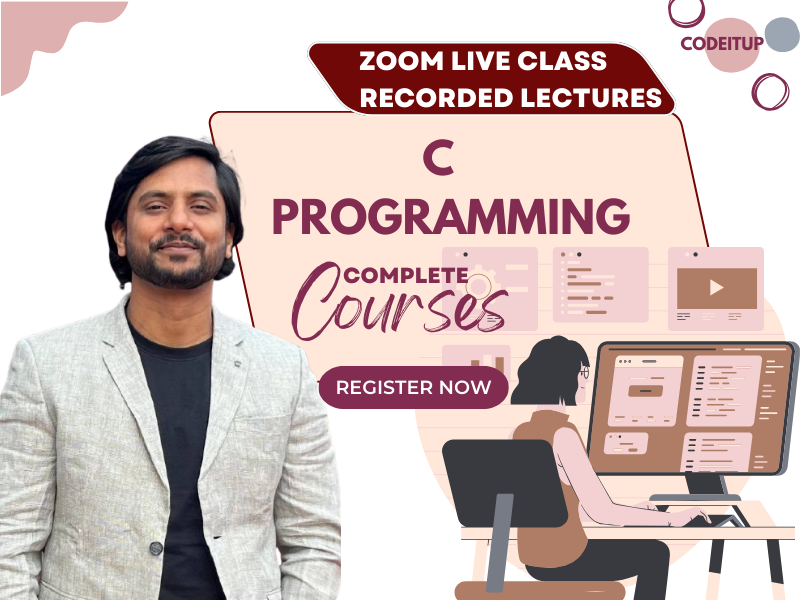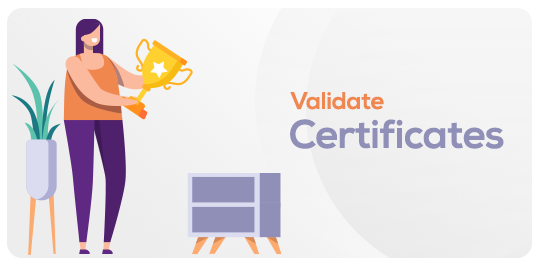Complete C Programming Course By Anand Sir Online LiVE Class Recorded Lecture
in LanguageWhat you will learn?
Comprehensive Coverage: Gain in-depth understanding of key concepts in C programming.
Flexibility: Learn at your own pace and schedule, fitting your studies around your other commitments.
Expert Instruction: Access high-quality teaching from Anand Sir, ensuring clarity and depth in your learning.
Convenience: Study from anywhere with an internet connection, eliminating the need for physical attendance.
About this course
Dear Learner,
Greetings from CODEITUP!
Welcome to the Complete C Programming Course. This self-paced online course offers pre-recorded videos of classes conducted by Anand Sir. You have the flexibility to complete the video course on C programming highlighting key points.
Highlights:
- Expert Instruction: Anand sir has more than 15+ years of teaching experience so he teaches student in such most easiest way that student can understand easily for guarantee.
- Hands-on Projects: Hands-on projects are included in the course.
- Comprehensive Material: You will get in-depth, comprehensive material.
- Community Support: You can directly ask about your issue from your course dashboard, forums or community support for doubt-clearing and discussion.
- Certification: You can ask for certification upon course completion for added value.
1. Introduction to C Programming
- History and Importance: Brief history, its impact on modern languages, and its relevance today.
- Course Overview: What the course will cover, expected outcomes, and prerequisites.
2. Fundamental Concepts
- Basic Syntax and Structure: Explanation of C syntax, structure of a C program, compiling, and running a program.
- Data Types and Variables: Introduction to various data types (int, float, char), variable declaration, and scope.
3. Operators and Expressions
- Arithmetic Operators: Usage of addition, subtraction, multiplication, division, and modulus.
- Relational and Logical Operators: Comparison and logical operations.
- Bitwise Operators: Introduction to bitwise manipulation.
4. Control Flow
- Conditional Statements: If-else, switch-case.
- Loops: For, while, do-while loops, and their applications.
- Jump Statements: Break, continue, goto, and exit.
5. Functions
- Function Basics: Declaration, definition, and calling functions.
- Parameter Passing: Pass by value and pass by reference.
- Recursion: Concept of recursive functions.
6. Arrays and Strings
- Array Declaration and Initialization: Single and multi-dimensional arrays.
- String Handling: String functions and manipulation.
7. Pointers
- Introduction to Pointers: Pointer syntax, pointer arithmetic, and pointer operations.
- Dynamic Memory Allocation: malloc, calloc, realloc, and free.
- Pointers and Arrays: Relationship between pointers and arrays.
8. Structures and Unions
- Defining Structures: Syntax, nested structures, and array of structures.
- Unions: Definition and difference from structures.
9. File Handling
- File Operations: Opening, reading, writing, and closing files.
- File Modes: Different modes for file operations.
10. Advanced Topics
- Preprocessor Directives: Macros, conditional compilation, and file inclusion.
- Memory Management: Concepts of stack and heap.
- Error Handling: Common errors, debugging techniques, and error handling functions.
11. Practical Applications
- Project Development: Step-by-step guide to developing small projects.
- Real-world Examples: Examples of how C is used in operating systems, embedded systems, and performance-critical applications.
12. Conclusion
- Summary of Key Points: Quick recap of what has been learned.
- Next Steps: Suggestions for further learning and advanced courses.
Visual and Content Tips
- Interactive Quizzes: Include quizzes and interactive content to keep students engaged.
- Real-world Case Studies: Showcase real-world applications and case studies.
Happy Learning!
Suggested by top companies
Top companies suggest this course to their employees and staff.

Requirements
Only Phone or Laptop or Computer or Smart TV with Internet Connection
C Programming compiler Software
Comments (0)
In this video, the basics of the C Programming Language has been explained. In addition the different types of programming terminologies and related definition terms along with syllabus has been explained.
In this video, TOKEN concept has been explained. Inside TOKEN, Keywords, Identifiers, Literals and Punctuators have been explained.
In this video, different types of C Operators has been explained like Arithmetic, relational, logical, assignment, bitwise and many more. Along with this the Structure of ‘C’ program has also been explained.
In this video, we will learn how to write simple C programs and how to get them executed using different C compilers. We can used “Turboc++”, CodeBlocks, DevCetc to execute the C Programs. For learning purpose, we will be using either TurboC++ compiler of CodeBlocks. Let’s learn and execute C Programs.
In this video, we will learn about the concept of Control statement which is one of the important topic of C Programming. Control statements are the backbone of any programming language. We have to learn three kinds of Control Statement in C Programming i.e. Selection Control Statement, Jump Control Statement & Looping or Iterative Control Statement.
In this video, we will learn about some question from Selection Control Statement as well Introduction to Looping. Along with this we will learn some of the C Loop Questions.
In this video, we will learn about important questions related to C programming. There are many questions in looping which are important and hence we will complete all those question in 04 parts. This is the first part.
In this video, we will learn about important questions related to C programming. There are many questions in looping which are important and hence we will complete all those question in 04 parts. This is the second part.
In this video, we will learn about important questions related to C programming. There are many questions in looping which are important and hence we will complete all those question in 04 parts. This is the third part.
In this video, we will learn about important questions related to C programming. There are many questions in looping which are important and hence we will complete all those question in 04 parts. This is the fourth and final part.
In this video, we will learn about For Loop in C Programming. C Supports three types of loop statement, while loop, do-while loop and for loop. In this video, we will learn about For loop.
In this video, we will learn about the next control statement i.e. Jump Control Statement which is Break & Continue. In addition we will also learn switch Statement.
In this video, we will learn about the different Pyramid Printing concepts. After learning looping, it is one of the important topic that improves your logical capability. You need to learn it well in order to strengthen your logical capabilities.
In this video, we will start the next chapter of C Programming i.e. “Array”. Array is another important topic of C programming which is used to store similar types of elements in large quantity.
In this video, we will learn about the “Array Programming” concepts. We will be learning how to implement the array concept using various questions related to array.
In this video, we will learn about two dimensional array which is a kind of array that is used to solve Matrix related problems.
In this video, we will learn about C Strings. Strings are basically character array in C Programming. When an array stores only characters then it is called String. We will also do different programs related to string programming.
In this video, we will learn about the Functions in C. Functions in C are sub programs that performs some specific task. In this video we will learn C functions introduction and its different types.
In this video we will learn about writing C programs using function. User-defined function in C can be written using four ways. We will learn the first two ways to write user defined function in this video. The two ways are:
No Argument No Return
With Argument No Return
In this video, we will learn about writing C programs using function. User-defined function in C can be written using four ways. We will learn the last two ways to write user defined function in this video. The two ways are:
No Argument with return
With Argument with return
In this video, we will learn about Pointers in C. Pointers in C are used to store addresses and the calculation is done using address. This make the program execution faster.
In this video, we will learn about the programming concepts in Pointer. Doing programming using pointer will enable us to run the program faster and also using lesser memory space.
In this video, we will learn about the topic Structure & Union. Structures in C are used to stored elements of different types. Union also do the same. Let’s learn more about them in this video.
In this video, we will learn about the concept of Recursion in C programming. Recursion in C is when a function calls itself. Let’s learn Recursion in details.
In this video, we will learn about the concept of File Handling in C. Using File Handling, we can create files in our system and can store the data in the file that will be permanently stored. This is the first part of File Handling programming in which we will learn the basics.
In this video, we will learn about the concept of File Handling in C. Using File Handling, we can create files in our system and can store the data in the file that will be permanently stored. This is the second part of File Handling programming in which we will programming related to File Handling.
In this video, we will learn about the concept of File Handling in C. Using File Handling, we can create files in our system and can store the data in the file that will be permanently stored. This is the third part of File Handling programming in which we will programming related to File Handling.










